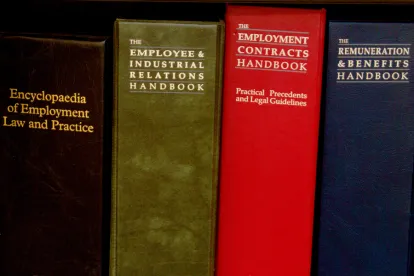On Sept. 8, 2020, a New York federal judge struck down substantial portions of the U.S. Department of Labor (DOL’s) joint employer final rule, which went into effect March 1, 2020. As reported in a prior GT L&E blog, the DOL’s final rule announced a four-factor balancing test for determining joint-employer status when one employer “suffers, permits, or otherwise employs the employee to work, but another individual or entity simultaneously benefits from that work.”
The DOL’s new test for joint employment — the first formal one promulgated in over 60 years — focuses only on the putative joint employer’s right to control the employee, in contrast to prior DOL interpretative guidance that looked at the worker’s economic dependence on the putative joint employer. The DOL had emphasized the benefits of a formal and uniform joint employment standard, contending that it would foster greater consistency within the law and more predictability for employers and employees.
The attorneys general of 18 states and Washington, D.C. sued to block the final rule in February arguing that it narrowed the definition of joint employment further than the FLSA permits. In granting summary judgment to the coalition of states challenging the rule, U.S. District Judge Gregory Woods in the Southern District of New York agreed with the states and concluded that the final rule violates the Administrative Procedures Act (APA).
Joint Employment Background
As Judge Woods’ decision acknowledges, the joint employer doctrine is longstanding, having been first recognized by the DOL in 1939. That year, the DOL issued an “interpretive bulletin” establishing that multiple employers could simultaneously employ an employee. In 1958, the DOL codified the joint employment standard by way of regulations which recognized that a single individual may simultaneously have two or more employers under the FLSA. See 23 Fed. Reg. 5905 (Aug. 5, 1958). Through these regulations, the DOL set forth that joint employment exists when the facts establish that employment by one employer is “not completely disassociated from employment by the other employer.”
The DOL has periodically updated this definition via informal guidance, most recently in 2014 and 2016, when the Wage and Hour Division, under the Obama Administration, issued Administrator Interpretations (AIs) directing investigators to look past employers’ control over workers to the “economic realities” of the relationship.
Under the Trump Administration, the DOL rescinded those memos in 2017, and last year proposed the first update to its formal joint employment regulations in decades. The final rule revised the standard for liability applied to vertical joint employment (i.e., when an employee works for one employer such as a staffing agency or professional employer organization but is economically dependent on another business with respect to the work), adopting a “four-factor balancing test” to determine joint employment. The final rule’s test calls for consideration of whether the alleged joint employer has the power to:
- Hire or fire the employee;
- Supervise and control the employee’s work schedules or conditions of employment;
- Determine the employee’s rate and method of payment; and
- Maintain the employee’s employment records.
Other factors may be relevant, “but only if they indicate whether the potential joint employer is exercising significant control over the terms and conditions of the employee’s work,” according to the DOL.
Another critical point from the final rule was that simply reserving the right to control working conditions is not enough to find one employer the joint employer of another. An alleged joint employer must actually exercise control over the employee’s working conditions.
Prior to the establishment of this clearer test as to when a company will be considered a joint employer for FLSA purposes, different courts routinely applied divergent standards in different circuits. Notably, the Second Circuit Court of Appeals had specifically rejected the four-part test, which was later adopted by the final rule, as the appropriate test for determining vertical joint employment under the FLSA. In Zheng v. Liberty Apparel Co., 355 F.3d. 61 (2d. Cir. 2003), the Second Circuit had ruled that such a test was unduly narrow as it could not be reconciled with the FLSA which states that an entity “employs” an individual under the FLSA if it “suffers or permits” an individual to work. The Zheng court noted that the terms “suffer or permit” were necessarily very broad in accordance with the remedial purpose of the FLSA, and that the appropriate test for vertical joint employment under the FLSA should determine “functional control” as opposed to “formal control.”
The Decision Striking Down the Final Rule
In a 62-page ruling, in New York v. Scalia, 2020 U.S. Dist. Lexis 163498, 1:20-cv-1689-GHW, (S.D.N.Y. September 8, 2020), Judge Woods vacated the portion of the final rule applying to “vertical” employment relationships, while letting stand the portion of the final rule applying to “horizonal” relationships, in which a worker is employed by two “sufficiently associated” businesses.
Judge Woods held that the DOL’s final rule violated the APA under two separate analyses: 1) that it was contrary to law (the FLSA); and 2) that the final rule was arbitrary and capricious.
Contrary to Law
Judge Woods held that the final rule is contrary to law because it conflicted with the FLSA in two ways: 1) in its reliance on the FLSA’s definition of “employer” as the sole textual basis for joint employer liability; and 2) in the final rule’s creation of separate tests for whether an entity is an “employer” and whether the entity is a “joint employer.”
More specifically, Judge Woods held that the new rule impermissibly based joint employer liability only on the FLSA definition of “employer,” while ignoring the three interrelated definitions within the FLSA for “employer,” “employee,” and “employ.” He further emphasized that the FLSA defines the verb ‘employ’ expansively to mean “suffer or permit work,” and noted this definition’s “striking breadth.” Judge Woods specifically cited to the 2014 AI and the Second Circuit’s Zheng decision noting that a test that “focuses solely on the formal right to control the physical performance of another’s work is unduly narrow,” and also adding, again citing to the 2014 AI and Zheng, that “a control-based test conflicts with the ‘suffer or permit’ language in the FLSA, which . . . reaches beyond traditional agency law.”
The court further held that there is no independent test for “joint employment” under the FLSA, but rather that “[a]n entity is an employer if it meets the FLSA’s definition and that “[i]t is a joint employer if it meets the definition and another entity also meets the definition.” In attempting to create distinct tests to qualify as an “employer” or a “joint employer,” the final rule contradicted the DOL’s past understanding and positions, according to the ruling.
Along the same line,the court held that the new rule departed from prior caselaw interpreting the FLSA and specifically took issue with the new rule’s reliance on “control” as the touchstone of joint employer liability. Judge Woods held that this concept impermissibly follows the common-law standard, and that the FLSA expressly rejects the common-law definition of employment. Conceding that the final rule’s four factors related to control can be relevant to the joint employer inquiry, and that such factors may even constitute sufficient conditions for joint employer status, the judge held the conclusion that an employer must satisfy one or more of the control factors as a necessary condition for joint employment conflicts with the FLSA. The judge further stated that the final rule’s allowance of “the consideration of additional factors” did not cure the problem because such factors were still limited “to those that indicate control.”
The decision further faulted the final rule for expressly stating that whether the employee is economically dependent on the potential joint employer is irrelevant. Instead, the judge held that excluding such economic dependence as a factor contradicts caselaw and the DOL’s own prior representations.
Arbitrary and Capricious
In addition to striking down the final rule because the judge found that it conflicted with the FLSA and its jurisprudence, the judge also set aside the final rule on grounds that it was arbitrary and capricious for three reasons:
| 1. | Unexplained Inconsistency |
The court held that the DOL did not adequately explain why it departed from prior interpretations, noting that while an agency is free to change existing polices as long as it provides a reasoned explanation for the change, the DOL had not done so here. The judge stated that the DOL did not adequately explain why it departed from prior interpretations, or from the 2014 and 2016 AIs. “That inconsistency demands an explanation, but the Final Rule gives none.”
| 2. | Conflict Between the FLSA and MSPA |
The judge also held that the final rule is arbitrary and capricious as it conflicted with the definition of joint employment under the Migrant and Seasonal Agricultural Workers Protection Act (the “MSPA’), despite MSPA regulations which expressly state that the joint employment test should be the same under both the MSPA and FLSA. As such, the court highlighted that applying different standards for joint employer liability under the FLSA and MSPA could lead to increased costs for employers subject to both standards, and that the final rule had not acknowledged those costs or explained why other benefits of the final rule might outweigh them.
| 3. | Cost to Workers |
Finally, the judge ruled that the final rule was arbitrary and capricious because it did not adequately consider the rule’s cost to workers. In doing so, the judge dismissed the DOL’s arguments that even if the final rule reduced the number of joint employers, it would not affect the wages due the employee under the FLSA as employees would only be entitled to payment by one entity. The court dismissed this argument stating that such a rationale would only be true if all employers fulfilled their legal obligations, and noted that “the whole point of joint employer liability” was to allow workers to “recover from a joint employer when their primary employer flakes on its legal obligations.”
In closing, the court stated that while the DOL’s “justifications for engaging in rulemaking are valid,” and that “[p]romoting uniformity and clarity given the (at least superficially) widely divergent tests for joint liability in different circuits is a worthwhile objective” that “the Department must do better than this.” The judge set forth that “[a]ny future rulemaking must adhere to the text of the FLSA and Supreme Court precedent.”
Implications
While the DOL may appeal, the decision invalidates the final rule at least for now, and creates uncertainty for employers. Judge Woods essentially rejected the control test in the context of vertical employment, and instead endorsed the 2014 and 2016 AIs that looked at the economic dependence of the employee on the putative joint employer. However, those AIs have been withdrawn by the DOL under the Trump Administration, and employers are presumably left to rely on the 1958 rule. Within the Second Circuit, employers should consider operating under the test set forth in the Zheng decision, which states that the following factors should be used to determine if a company is a joint employer of a subcontractor:
| 1. | Whether the company's premises and equipment are used for the employee's work; |
|
| 2. | Whether the subcontractor has a business that can or does shift as a unit from one putative joint employer to another; |
|
| 3. | The extent to which the employee performs a discrete line-job that is integral to the company's process of production; |
|
| 4. | Whether responsibility under a contract between the subcontractor and the company could pass from one subcontractor to another without material change; |
|
| 5. | The degree to which the company or its agents supervise the employee's work; |
|
| 6. | Whether the employee works exclusively or predominantly for the company. |
However, uncertainty remains as to whether the scope of the decision will extend beyond the Southern District of New York to the 17 states and District of Columbia challenging the rule, or even nationwide.
In sum, the guidance provided by the DOL in enacting the joint employment final rule has at least been put on hold pending an appeal and/or the DOL’s attempt to promulgate a new rule that can pass muster under this decision.






 />i
/>i

